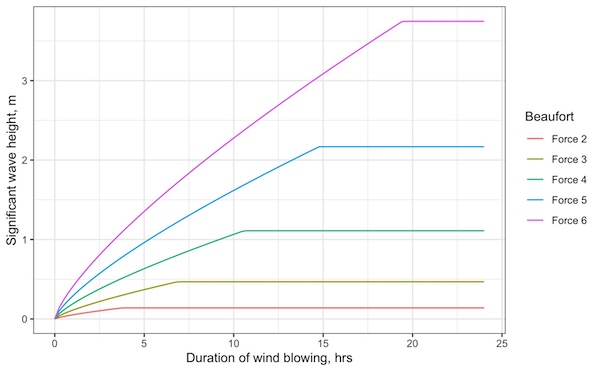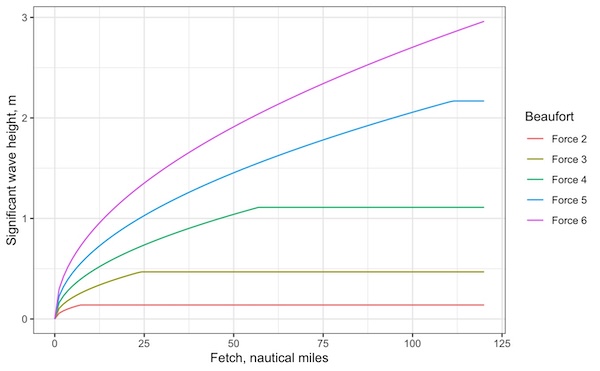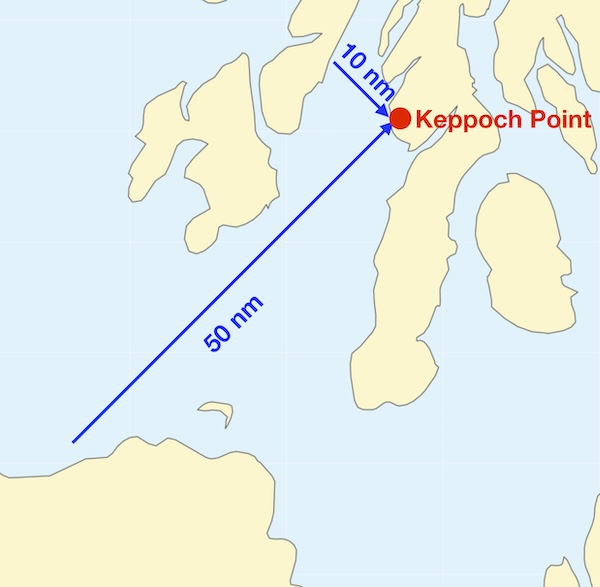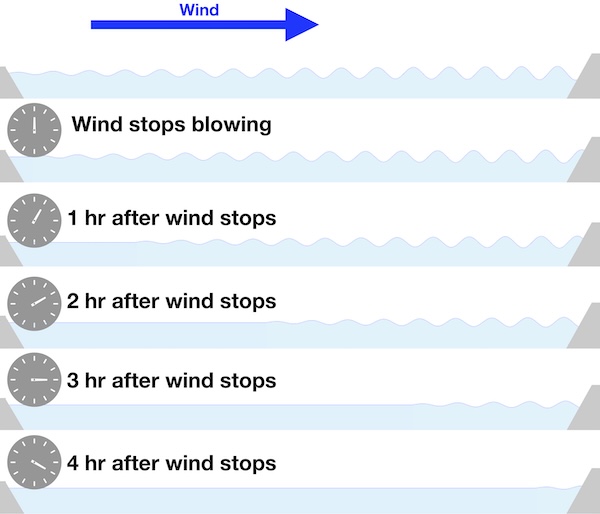3.1 Wind waves
3.1.1 Wind forming waves
Waves form when wind blows across the surface of the sea. The details of how this happens are complex and, surprisingly, not fully understood.
When waves are very small, the ‘restoring force’ that drives them is not gravity, but the surface tension of the water. These small waves are known as ‘capillary waves’. You can think of the surface of the water behaving a bit like a rubber sheet.
If we disturb the surface of some flat water, for example by dropping a stone into it, some waves will form with a period and wavelength that is characteristic of the properties of the water - specifically its density and surface tension. These small waves tend to have a wavelength of about 1.7 cm - we might say that the surface ‘resonates’ with this wavelength.
When wind blows across a flat sea, there will be some turbulence that causes local areas of increased pressure. The location of these small impulses will be random, but because the water surface has a preferred ‘resonant’ wavelength, the impulses that reinforce the 1.7 cm waves will tend to build up the wave height, while those that don’t will have a lesser effect.
Once some waves have started to form, the wind can push on them to increase their size further. This happens through several mechanisms:
The wind blows on the windward side (front) of the wave, pushing it along and piling more water up.
The wind curves over the top of the wave, almost like it might curve over the top of an airplane wing. The resulting low pressure pulls the wave peak upwards.
The wind eddies behind the wave, pulling the wave along, and pushing down on the trough.
Clearly, all of these effect will be more pronounced on bigger waves. As a result, a positive feedback effect occurs - as the waves get bigger, the wind can act on them more strongly, making them bigger still. As a result, the waves grow exponentially.
Eventually, a limit is reached at which the waves can’t get any bigger for the speed of the wind - one mechanism is that the waves eventually move at (or faster than) the speed of the wind.
One final, and rather strange, effect occurs whilst this is going on. The waves interact with each other to produce waves with longer wavelengths. One of the results of this is that many of the waves actually end up travelling faster than the wind by about 17%.
The size of the waves that are formed depends on:
The wind speed
How long the wind has been blowing over the sea
The plot below gives a feel for how wave heights might grow with time for a few different wind speeds:

As we’d expect, as the wind blows for longer, the waves get higher. But for any wind speed, a limit is reached when the waves stop growing. This is known as a ‘fully developed sea’. The time taken to get to this stage depends on how strong the wind is blowing.
3.1.2 Fetch
The time for which the wind has blown across the sea might be limited by:
The weather conditions - it might only be an hour since the wind started blowing, or the wind direction may have changed
The distance that the wind can blow across the water - this is known as the fetch. If there’s only 10 km of sea upwind of you before the next bit of land, that limits the time the waves can be blown by the wind until the waves reach you.
The image below illustrates waves increasing with fetch as the wind blows across a body of water:

Wind blowing across a body of water. The upwind, sheltered shore is known as the ‘lee’ shore. The downwind shore is called the ‘weather’ shore. The distance between them is the fetch. The water is flat at the lee shore, but the waves increase in size as the wind blows across the water to the weather shore.
Clearly, paddling conditions will be very different on the sheltered ‘lee’ shore and the exposed ‘weather’ shore. On the lee shore, the water will be flat, and the land may provide some shelter from the wind. The weather shore offers no shelter and the waves may be significant, depending on the fetch. Obviously, a group journeying along a lee shore need to take care - if they stray offshore, conditions will become continually more difficult, and getting back to the shore may be challenging.
The fetch can have a big effect on the waves that we experience. The plot below shows roughly how wave height varies with wind speed and fetch:

We see a similar pattern as we did on the previous plot. Stronger winds create bigger waves. As the wind blows over the sea for a longer distance, the waves get bigger, but eventually a limit is reached - the fully developed sea state.
What waves might you expect at Keppoch Point on the east side of the sound of Jura with a force 4 wind:
From the south-west?
From the north-west?
From the north east?

If the wind is blowing from the south-west, there is nothing to block the waves between Keppoch Point and the north coast of Ireland - a fetch of about 50 nautical miles. Over this distance, we’d expect the force 4 wind to have created an almost fully developed sea state, with waves a bit bigger than a metre.
If the wind is blowing from the north-west, the fetch is much less due to the Isle of Jura about 10 nautical miles in this direction. We’d expect smaller waves - perhaps a bit less than half a metre.
If the wind blows from the north-east, the fetch is zero - the sea being sheltered by the land. We’d expect the sea to be flat if this wind is the only consideration.
The table below gives the fetch and duration required to raise a fully developed sea for different wind speeds. It also gives typical wave heights and periods for the fully developed sea.
| Beaufort | Wind speed, kt | Fetch to fully develop, nautical miles | Time to fully develop, hrs | Typical wave height, m | Typical wave period, s |
|---|---|---|---|---|---|
| F3 | 9 | 25 | 7 | 0.5 | 4 |
| low end F4 | 12 | 50 | 10 | 1 | 5 |
| high end F4 | 15 | 70 | 12 | 1.5 | 6 |
| F5 | 19 | 120 | 15 | 2.4 | 8 |
| F6 | 25 | 220 | 20 | 4 | 10 |
| F7 | 30 | 300 | 24 | 6 | 13 |
3.1.3 Time to drop off
When the wind stops blowing, the waves don’t disappear. They don’t get any bigger, but they will keep moving in the direction they were moving in until they reach a shoreline.

Simplified diagram of what happens after the wind stops blowing over a body of water. The wind blows from left to right, but stops at 12:00. However, the waves on the weather shore aren’t affected much. The waves remain high on the water shore for the next few hours as the wind generated waves keep travelling across the water. By 15:00 (3 hours after the wind has stopped), the waves are getting smaller, and by 16:00 (4 hours after the wind has stopped), they have almost stopped entirely.
How long it takes for the waves to drop after the wind stops blowing will depend on how strong the wind was and on the fetch. A very simple rule of thumb is that the waves might become small after a time in hours equal to the fetch (nautical miles) divided by 4. So, in our example above with a 50 nautical mile fetch, it might take 12 hours for the waves to drop. Clearly if the fetch is long, we might expect there to be significant waves for a day or two after a strong wind has stopped blowing.
If the waves generated are large, they can keep moving across the ocean for a very long distance - so that we might experience waves generated by distant winds that never affect us directly. We call these waves ‘swell’, and we’ll now look at them in more detail.